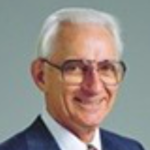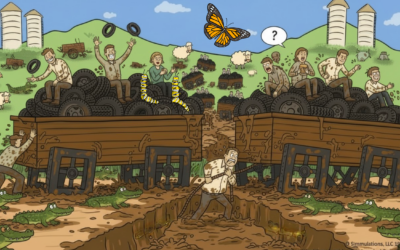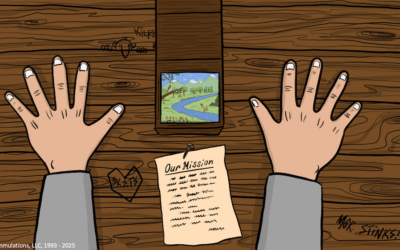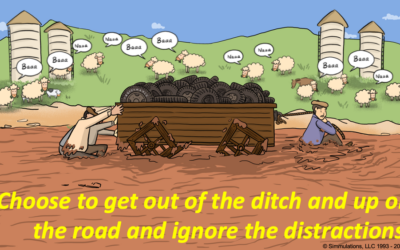This “What Would Bob Mager Do” is the fourth in a series of posts I am doing to share about key organizational development frameworks. Sure, many are Old School ideas, but very solid and fully developed frameworks that are generally ignored. Bob Mager was a major influencer on how to train and engage people in learning.
Note: I’m frustrated. And I have felt that way for a LONG time. In my early years, I had hope we could improve organizations through training and consulting but Gallup, Arbinger, Bersin and much other research clearly shows NOTHING has really improved.
I am waiting for AI to start culling the bad managers from the workplace after having read a LOT of different books about organizations and leadership and management over the past 50 years. We have the metrics, we just need some effective actions.
What Would Bob Mager Do to Improve Organizational Performance? I was curious…
Working on themes of organiational performance for the past 45 years and knowing that we have generated wonderful models and researched possibilities for leadership development and so many other organizational things over the past 50 to 100 years, I keep asking myself why we keep reinventing the wheel. Surely we already know the answers.
 Who is Bob Mager, you might wonder?
Who is Bob Mager, you might wonder?
Robert F. Mager (1923-2020) was an influential American psychologist and author who made significant contributions to the fields of instructional design, training, and human performance improvement. His best-known and most influential work was “Preparing Instructional Objectives” (1962), which sold over 1 million copies.
I remember reading this book and I was also very much influenced by his simple quotes about people and performance:
- On Performance Problems:
- “If you held a gun to their head and they could now do it, you don’t have a knowledge/skills problem, you have a motivation problem.”
- On Training and Performance:
- “Training isn’t the solution to a performance problem” .
- On Instructional Objectives:
- “If you don’t know where you’re going, you’ll probably end up somewhere else” .
- On Learning and Evaluation:
- “You haven’t taught until they have learned” .
These quotes encapsulate Mager’s focus on practical, performance-based approaches to training and his belief in the importance of clear objectives and learner outcomes. Although his focus was on training kinds of approaches, he had clear ideas about performance and that people need to be aware of how things are working and what things need improvement. It was about really looking at how things worked.
To improve performance in organizations using Bob Mager’s approach, leadership should focus on several key principles rooted in his Criterion Referenced Instruction (CRI) methodology and performance-based learning objectives. Here are the steps and actions that Mager would likely recommend:
Steps to Improve Performance
1. Identify Clear Goals and Objectives
- Task Analysis: Conduct a thorough analysis to identify the specific competencies and skills required for each role within the organization. This involves understanding what needs to be learned and the desired outcomes.
- Performance Objectives: Develop clear, measurable objectives that specify what the learner should be able to do after the training. These objectives should include the performance, conditions, and criteria for success. Followup for implementation.
2. Ensure a Supportive Environment
- Expectations and Feedback: Clearly communicate performance expectations and provide regular feedback. Employees should know what is expected of them, under what conditions, and how their performance will be evaluated.
- Tools and Resources: Ensure that employees have access to the necessary tools, resources, and support to perform their tasks effectively. This includes providing reference materials, system access, and a conducive work environment.
3. Use Criterion Referenced Instruction (CRI) for Training
- Criterion-Referenced Testing: Develop assessments that are directly tied to the performance objectives. These tests should measure whether employees have achieved the required level of competency.
- Learning Modules: Create instructional modules that align with the performance objectives. These modules should be designed to help learners achieve mastery in specific skills or knowledge areas.
4. Provide Opportunities for Practice and Feedback
- Practice and Application: Allow employees to practice the skills they have learned in a controlled environment. Provide opportunities for repeated practice to ensure retention and proficiency.
- Feedback Mechanisms: Implement systems for providing constructive feedback on performance. This helps learners understand their progress and areas for improvement.
5. Align Training with Organizational Needs
- Organizational Goals: Ensure that the training programs are aligned with the overall goals and needs of the organization. This involves continuous assessment and adjustment of training programs to meet evolving business requirements.
- Employee Development: Focus on career development and skill enhancement to improve employee retention and job satisfaction. This can lead to better performance and a more motivated workforce.
Actions Leadership Should Do Differently
1. Focus on Performance Outcomes
Leadership should shift their focus from merely delivering training to ensuring that training leads to measurable performance improvements. This involves setting clear, performance-based objectives and continuously evaluating the effectiveness of training programs. Note that this is NOT about competition and it IS a focus on measurable results and observable behaviors. And collaboration among players is supportive of improvement.
2. Create a Culture of Continuous Continuous Improvement
Encourage a culture where continuous learning and improvement are valued. Leadership should support ongoing development initiatives and provide opportunities for employees to enhance their skills regularly.
3. Provide Adequate Support and Resources
Ensure that employees have the necessary support and resources to apply what they have learned. This includes providing access to tools, creating a supportive work environment, and removing barriers to performance.
4. Engage in Regular Performance Analysis
Regularly analyze performance data to identify gaps and areas for improvement. Use this data to refine training programs and ensure they are meeting the desired outcomes.
5. Involve Managers in the Training Process
Managers should be actively involved in the training process and held accountable for the on-the-job performance of their teams. Often, they have no clue as to what training their people receive, which can lead to unrealistic expectations of their behaviors.
Managers should provide ongoing support, monitor progress, and ensure that training is applied effectively in our workplaces.By following these principles and actions, leadership can create a more effective and performance-oriented training environment that aligns with Mager’s approach to improving organizational performance.

A desk is a dangerous place from which to view the world, especially when the manager is unsure as to the training of their people and having realistic expectations about change.
Here is a solid article on “old school” leadership about some practical insights into how to align culture with strategy and energize employees today.
https://www.strategy-business.com/blog/Leaders-should-revisit-the-works-of-three-corporate-culture-pioneers
Here are other profiles in my What Would... series:
#1 – What would Tom Peters Do – https://performancemanagementcompany.com/2024/07/02/what-would-tom-peters-do/
#2 – What would Peter Drucker Do – https://performancemanagementcompany.com/2024/07/08/what-would-peter-drucker-do/
#3 – What would Frederick Taylor Do – https://performancemanagementcompany.com/2024/07/13/what-would-frederick-taylor-do/
#5 – What would W. Edwards Deming Do? – https://performancemanagementcompany.com/2024/07/23/what-would-deming-do/
The Truth is Out There! (so go read about it!)
—
For the FUN of It!
 Dr. Scott Simmerman is a designer of team building games and organization improvement tools.
Dr. Scott Simmerman is a designer of team building games and organization improvement tools.
Managing Partner of Performance Management Company since 1984, he is an experienced presenter and consultant who is trying to retire!! He now lives in Cuenca, Ecuador.
You can reach Scott at scott@squarewheels.com
Learn more about Scott at his LinkedIn site.
Here is a link to a press release about The Search for The Lost Dutchman’s Gold Mine teambuilding exercise and its 30 years of positively impacting people and performance.
Square Wheels® is a registered trademark of Performance Management Company
The Search for The Lost Dutchman’s Gold Mine is a trademark of Performance Management Company
Square Wheels and Lost Dutchman images © Performance Management Company, 1993 – 2024. All rights reserved.








0 Comments